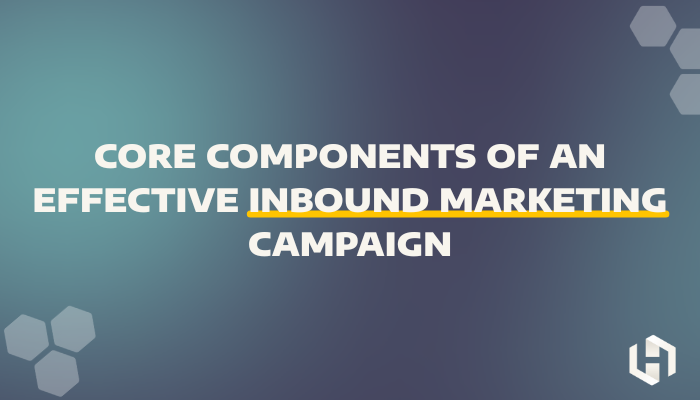Remember the days of obnoxious cold calls and spam emails shoved in your face? Those interruptive "BUY! BUY! BUY!" tactics did nothing but alienate potential customers. Thankfully, a smarter, customer-centric approach to marketing has emerged - one that attracts prospects by creating valuable, tailored content they actually want to consume.
It's called inbound marketing, and it turns the old outbound playbook on its head. Rather than force-feeding disruptive sales messages, inbound is about earning attention and trust by providing uniquely helpful content at just the right moments as buyers move through their journey. While straightforward in concept, building an effective inbound engine requires carefully combining several interconnected components. In this article, we'll walk you through the four key components of an effective inbound marketing campaign.
What Makes an Inbound Campaign Effective?
An effective inbound marketing campaign is like a well-oiled machine with multiple components working together seamlessly. From upfront planning and persona development to content creation, lead nurturing, and measurement - each element plays a crucial role in attracting, engaging, and delighting your audience.
So what are the key ingredients? Let's break down the core components:
- Lay the Foundation
- Build Assets to Attract & Convert
- Nurture Leads & Promote Content
- Leverage Tools & Measure Results
1. Lay the Foundation
Before you can start executing an inbound campaign, you need to lay a solid strategic foundation. This first critical stage involves deeply understanding your target audience and defining the objectives you want to accomplish. Without this foundational work, your campaign efforts will be unfocused and likely miss the mark.
Buyer Personas: First and foremost, you need to develop detailed buyer personas that represent your ideal customers. Define their demographics, behaviors, goals, challenges, and pain points. Having comprehensive personas will allow you to create content that resonates with your target audience.
Campaign Theme and SMART Goals: Determine a unifying theme for your campaign that addresses a core problem, challenge, or interest relevant to your buyer personas. Then, set SMART goals (Specific, Measurable, Attainable, Relevant, Time-bound) to define what you want to achieve and measure success.
2. Build Assets to Attract & Convert
With your strategy set, it's time to build the core assets that will attract prospects to your business and convert them into leads. This involves creating compelling offers, optimizing content for search, and designing intuitive conversion paths. These components work together to capture the attention of your personas and provide them value in exchange for their contact information.
Keyword Strategy: Conduct keyword research to identify the terms and phrases your personas use when searching for solutions. Build a keyword strategy incorporating both broad and long-tail keywords to optimize your content for search engines.
Premium Content Offer: Create a compelling content offer, such as an ebook, webinar, or toolkit. This offer should be a piece of helpful content that provides a high value to your personas and incentivizes them to exchange their contact information. The offer should be purely educational, not a thinly-disguised sales pitch.
Conversion Path: Design a seamless conversion path consisting of a call-to-action (CTA), landing page, form, thank you page, and follow-up email. Make it easy for visitors to access and download your premium offer in exchange for becoming a lead.
3. Nurture Leads & Promote Content
Simply generating leads isn't enough - you need to nurture them through the buyer's journey until they are sales-ready. This section focuses on continuing to deliver value through automated lead nurturing campaigns while simultaneously promoting your content assets through multiple channels. An integrated approach keeps leads engaged while expanding the reach of your inbound efforts.
Lead Nurturing: Implement automated lead nurturing campaigns with a series of emails that continue providing value to new leads. These campaigns should gradually move personas through the sales funnel from awareness to consideration to decision stage.
Content Creation and Promotion: Produce high-quality, persona-targeted content like blog posts, videos, infographics and more to attract visitors and feed your promotional channels. Distribute this content via your website, social media, email, guest posting, influencer outreach and paid advertising.
4. Leverage Tools & Measure Results
While the other components involve building the engine of your inbound campaign, this section is about incorporating tools to streamline operations and measure performance. Marketing automation facilitates scalability, while data-driven analytics allow you to continually optimize your tactics. Closing the loop with revenue reporting demonstrates the true business impact. Leveraging technology and metrics is key to managing modern inbound campaigns.
Marketing Automation: Streamline processes by using marketing automation tools to handle lead capture, scoring, nurturing, analytics, and other repetitive tasks. This allows you to scale your efforts efficiently.
Analytics and Closed-Loop Reporting: Continuously measure your campaign performance using web analytics, lead tracking, and revenue data. Feed these insights back into your strategy to iteratively optimize your tactics and understand the true ROI of your inbound efforts.
By strategically combining these core components, you'll be able to design and execute an inbound marketing campaign that successfully attracts, engages and delights prospective buyers at every stage of their journey.
While achieving true inbound success requires carefully integrating multiple components like personas, automation, and analytics, the payoff is the ability to engage audiences through their preferred channels with a relevant, facilitative experience - not another disruptive sales pitch. The outdated outbound playbook simply falls flat in today's environment of empowered buyers who crave value and relevance over pressure. Inbound allows you to attract by actually serving your audience's interests first.



.png?width=100&height=100&name=The%20Complete%20Guide%20to%20HubSpots%20Prospecting%20Agent%20(2025%20Edition).png)

.png?width=100&height=100&name=Why%20Were%20Not%20a%20Marketing%20Agency%20(And%20What%20That%20Means%20for%20Your%20Growth).png)